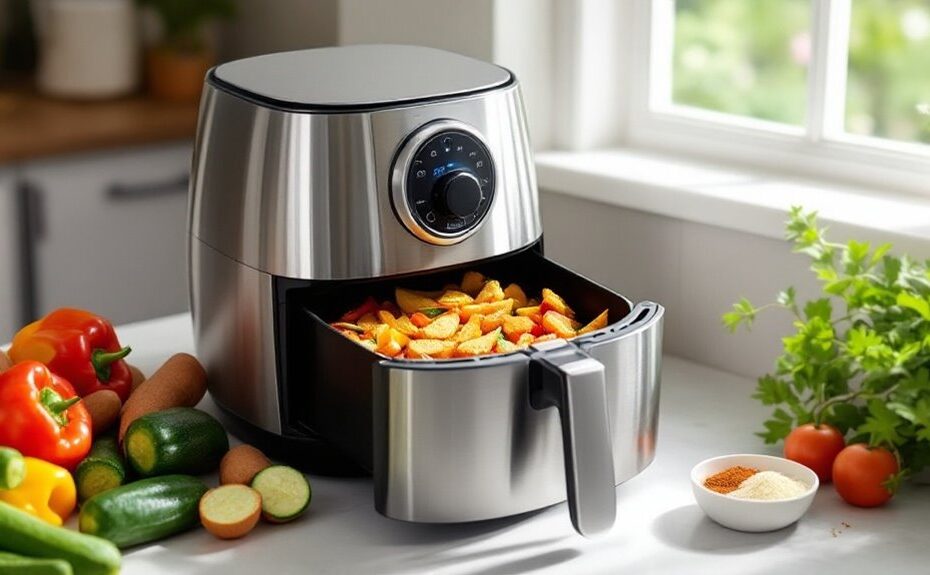If you've ever enjoyed crispy roasted vegetables without a sprinkle of salt, you've already experienced how cooking methods can enhance natural flavors. An air fryer can be a game-changer for a low-sodium diet, as it uses rapid hot air circulation to create texture and taste without relying on added salt. But how do you make the most of this tool while keeping sodium levels in check? From choosing the right ingredients to experimenting with herbs and spices, there's more to explore about crafting flavorful, low-sodium meals that don't compromise on satisfaction.
Key Takeaways
- Air fryers enhance natural flavors with rapid hot air circulation, reducing the need for added salt in low-sodium diets.
- They require little to no oil, making meals healthier while maintaining satisfying textures and flavors.
- Fresh, unprocessed ingredients like vegetables and lean proteins are ideal for air frying to control sodium levels.
- Experiment with herbs, spices, and citrus zest to add bold flavors without relying on salt.
- Air fryers cook meals quickly, preserving nutrients and offering versatility for low-sodium recipes like veggie chips or seasoned proteins.
Benefits of Air Fryers for Low-Sodium Diets
While managing a low-sodium diet can feel restrictive, air fryers offer a practical solution by reducing the need for added salt without sacrificing flavor. Air fryers use rapid hot air circulation to crisp foods, enhancing natural tastes and textures. This method minimizes reliance on sodium-heavy seasonings or sauces, supporting your health benefits by lowering sodium intake. Cooking efficiency is another advantage, as air fryers prepare meals faster than traditional ovens, preserving nutrients better than boiling or frying. They also require little to no oil, reducing unhealthy fats while maintaining satisfying results. By streamlining meal prep and promoting heart-healthy eating, air fryers align with low-sodium dietary goals. Their versatility allows you to experiment with herbs, spices, and other flavor enhancers, making it easier to stick to your plan without feeling deprived.
Choosing Low-Sodium Ingredients for Air Frying
When choosing ingredients for air frying on a low-sodium diet, prioritize fresh produce like vegetables and fruits, as they're naturally low in sodium. Opt for lean proteins such as chicken breast, fish, or tofu, and avoid processed or pre-seasoned options that often contain added salt. Reading labels carefully guarantees you're selecting minimally processed foods to maintain sodium control.
Selecting Fresh Produce
To guarantee your air-fried meals align with a low-sodium diet, start by carefully selecting fresh produce, as it's naturally low in sodium and packed with essential nutrients. Prioritize seasonal selections, as they're fresher, more flavorful, and often more affordable. Organic options can also be a smart choice, as they're grown without synthetic pesticides, which may align with your health goals. Focus on vegetables like broccoli, zucchini, and bell peppers, or fruits such as apples and pears, which air-fry well and enhance flavor without added salt. Avoid pre-packaged or pre-seasoned produce, as these often contain hidden sodium. By choosing whole, unprocessed ingredients, you'll maintain control over sodium levels while maximizing nutritional value. This approach secures your air-fried dishes are both healthy and satisfying.
Opting for Lean Proteins
Lean proteins are a cornerstone of a low-sodium diet and work exceptionally well in an air fryer. Choose skinless poultry, fish, tofu, or legumes as protein alternatives to minimize sodium intake. These options are naturally low in sodium and retain moisture when air-fried, ensuring a flavorful result. Enhance their taste by using sodium-free marinades made with herbs, citrus, vinegar, or spices instead of high-sodium sauces. For example, marinate chicken breasts in lemon juice, garlic, and rosemary before air frying. Avoid pre-seasoned or processed meats, as they often contain added sodium. By selecting lean, unprocessed proteins and seasoning them thoughtfully, you can create satisfying, low-sodium meals that align with your dietary goals while maximizing the air fryer's efficiency.
Avoiding Processed Foods
Processed foods are often high in sodium, making them unsuitable for a low-sodium diet, but you can easily avoid them by selecting fresh, whole ingredients for air frying. Skip processed snacks like chips or pre-seasoned fries, which often contain added salt. Instead, opt for fresh vegetables, lean proteins, or homemade seasoning blends. Frozen meals, while convenient, are typically loaded with sodium for preservation. Instead, prepare meals in advance using low-sodium ingredients and freeze them yourself. Air frying allows you to create crispy, flavorful dishes without relying on high-sodium processed options. By focusing on whole foods and controlling your seasoning, you can enjoy satisfying meals while adhering to a low-sodium diet. This approach not only reduces sodium intake but also enhances the nutritional quality of your meals.
Flavoring Foods Without Added Salt
While reducing sodium in your diet, you can still enhance the flavor of your meals by using alternative seasonings and cooking techniques. Herb seasoning, such as basil, thyme, or rosemary, adds depth without extra salt. Spice blends like paprika, cumin, or turmeric provide bold flavors and are naturally low in sodium. Experiment with citrus zest, garlic, or vinegar to brighten dishes. Roasting or air-frying vegetables caramelizes their natural sugars, intensifying taste without added salt. Fresh herbs, such as cilantro or parsley, can be added after cooking for a burst of freshness. Avoid pre-mixed seasonings that often contain hidden sodium. Instead, create your own blends using dried herbs and spices. These methods guarantee your meals remain flavorful while supporting your low-sodium goals.
Air Fryer Recipes for Low-Sodium Meals
If you're following a low-sodium diet, an air fryer can be a versatile tool for preparing flavorful meals without relying on added salt. For healthy snacks, try air-fried zucchini chips or kale crisps seasoned with herbs like rosemary or thyme. These options provide crunch and satisfaction without excess sodium. For quick dinners, consider air-fried salmon or chicken breasts marinated in lemon juice, garlic, and black pepper. Pair them with air-fried vegetables like broccoli or Brussels sprouts for a balanced meal. You can also make low-sodium turkey meatballs or veggie patties, using oats and spices for binding and flavor. The air fryer's rapid cooking helps retain nutrients while delivering crispy textures, making it easier to enjoy delicious, low-sodium meals.
Tips for Reducing Sodium in Air-Fried Dishes
To reduce sodium in air-fried dishes, focus on using fresh, whole ingredients and avoiding pre-packaged or processed foods, which often contain hidden salt. Replace high-sodium seasonings with flavorful seasoning alternatives like garlic powder, onion powder, or smoked paprika. Experiment with homemade spice blends, combining herbs like oregano, thyme, and rosemary with citrus zest or chili flakes for added depth. Skip pre-marinated meats or sauces, opting instead to marinate with olive oil, vinegar, and fresh herbs. Rinse canned beans or vegetables to remove excess sodium before air frying. Use unsalted broths or stocks when preparing batters or coatings. By prioritizing fresh ingredients and creative seasoning alternatives, you can enjoy air-fried dishes that are both low in sodium and rich in flavor.
Comparing Air Frying to Other Cooking Methods
Air frying offers a healthier alternative to traditional frying methods, as it requires little to no oil, reducing fat content while still achieving a crispy texture. Compared to deep frying, air frying substantially lowers calorie and fat intake, making it ideal for a low-sodium diet. When you bake or roast, you often need added fats or oils, but air frying achieves similar results with minimal oil. In an energy efficiency comparison, air fryers typically use less energy than conventional ovens, heating up faster and cooking food more quickly. Additionally, air fryer maintenance is simpler than cleaning deep fryers or ovens, as most models feature dishwasher-safe components. By choosing air frying, you reduce sodium intake, save energy, and simplify cleanup, making it a practical option for healthier cooking.
Disclosure: As an Amazon Associate, I earn from qualifying purchases.



